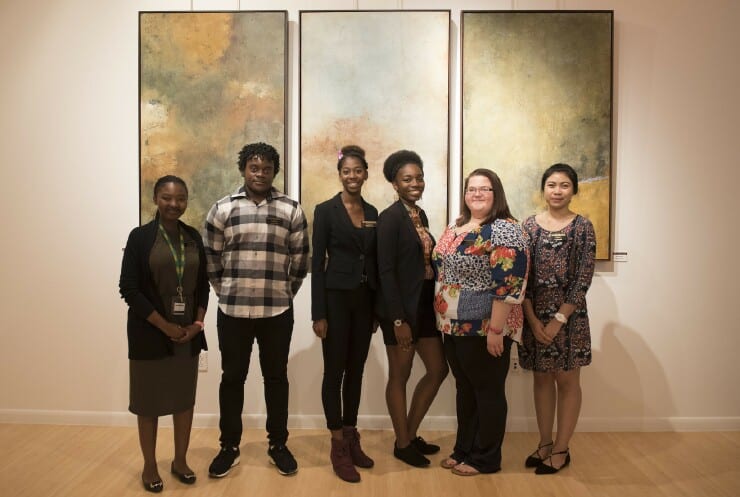
The David McCune International Art Gallery at Methodist University will host “Elemental,” a showcase featuring ceramic artist Akira Satake and painter Victoria Pinney. The showcase will open Sept. 22 and run through Nov. 17. In the spring, the gallery will host a photography exhibit, “Impressions to Modernism: Masterworks of Early Photography.” Both exhibits are free and open to the public.
The David McCune International Art Gallery at Methodist University will host “Elemental,” a showcase featuring ceramic artist Akira Satake and painter Victoria Pinney. The showcase will open Sept. 22 and run through Nov. 17. In the spring, the gallery will host a photography exhibit, “Impressions to Modernism: Masterworks of Early Photography.” Both exhibits are free and open to the public.
“We look forward to having ‘Elemental: Ceramics and Abstract Paintings’ in the gallery this autumn,” said Silvana Foti, executive director of the gallery. “It is a privilege to have Satake and Pinney’s work on display on our campus.”
“We are excited to continue our tradition of first-class art exhibitions for our campus and greater community,” said Dr. Ben Hancock, president of Methodist University. “And the future holds so many possibilities to showcase artistic excellence.”
The opening reception for “Elemental” will begin in the gallery at 6:30 p.m. on Sept. 22. The gallery will be open Tuesday-Friday, 11 a.m. to 5 p.m. and Saturdays, noon to 4 p.m. It will be closed Sundays, Mondays, Oct. 17-18, and Nov. 11.
About the fall exhibit artists
Akira Satake was born in Osaka, Japan, and has been living in the United States since 1983. Satake has been awarded the National Award for Excellence in Contemporary Clay by the Philadelphia Museum. “A Craftsman’s Legacy,” a national weekly television series on PBS, has featured his life and work.
“For me, the act of creation is collaboration between the clay, the fire, and myself,” said Satake. “Collaboration means finding out what the clay wants to be and bringing out its beauty in the way that the beauty of our surroundings is created through natural resources. Undulations in sand that has been moved by the wind, rock formations caused by landslides, the crackle and patina in the wall of an old house; all these owe their special beauty to the random hand of Nature. The fire is the ultimate random part of the collaborative equation. I hope the fire will be my ally, but I know it will always transform the clay in ways I cannot anticipate.”
In 2003, Satake relocated from Brooklyn, N.Y. to Swannona, N.C. He is widely sought after for workshops and lectures, and has been invited to give classes in France, Belgium, Israel, Australia, Bali, England, Portugal, and Scotland.
Victoria Pinney is a largely self-taught artist who works in an open studio in Asheville, N.C.’s River Arts District. She uses a mixture of oil paint and elemental substances, such as wax and sand, to give her art a historic feel.
“I find that things like rusted rail cars, crumbling stone walls, the mottled bark of a sycamore tree – even peeling paint – become microcosms of beauty that inspire my paintings,” said Pinney. “The textured surface is as essential to the painting as color or shape.”
Pinney is one of a select group of curated artists included in the Western North Carolina Design Guide. In 2015, she was featured in “American Art Collector.” In January 2016, she was recognized as an Emerging Artist in “Art Galleries and Artists of the South.”
Spring exhibit
“Impressionism to Modernism: Masterworks of Early Photography” celebrates an intrepid group of photographers at the turn of the 20th century on both sides of the Atlantic who fought to establish photography as a full-fledged art form. Their leader was Alfred Stieglitz, whose exhibition space, the “Little Galleries of the Photo-Secession,” and exquisitely printed magazine, “Camera Work,” advanced the vision of the most ambitious artist-photographers, including Heinrich Kühn, Gertrude Käsebier, Edward Steichen, and Clarence White, as well as Stieglitz himself.
This exhibit is drawn from the private collection of Michael Mattis and Judith Hochberg. The exhibit also covers the explosive aftermath of the Photo-Secession, when, starting with the work of Paul Strand in 1915-16, photography transitioned by fits and starts from Pictorialism to Modernism. The spring’s photography exhibit will run at McCune Gallery from Feb. 9 to April 8. More information about this show and the opening reception will be announced closer to the semester.
The David McCune International Art Gallery coordinates exhibitions of art by student, regional, national, and international artists, educating students and the public through a diverse representation of fine art. For more information about the gallery, please visit davidmccunegallery.org.
Pictured: “Kohiki” by Akira Satake